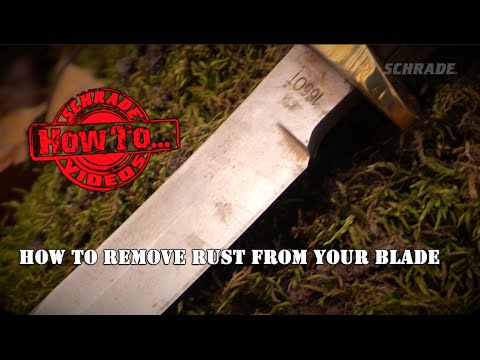
579e345939089d305e4bda0d2bdc4e40
Having a rusty knife can be a real nuisance. Not only does it look unsightly, but it can also be dangerous to use. Fortunately, it is possible to derust a knife and restore it to its former glory. In this article, we will provide a step-by-step guide on how to derust a knife. We will cover the different methods you can use, the materials you will need, and the safety precautions you should take. With this guide, you will be able to derust your knife quickly and easily.
How do you get rust off knives and forks
Rust can be a pesky problem when it comes to knives and forks. It can make them look unsightly and can even make them unsafe to use. Fortunately, there are a few simple methods you can use to get rid of rust and restore your cutlery to its former glory.
Using White Vinegar
White vinegar is a great natural rust remover. Simply fill a container with enough white vinegar to cover the rusty knives and forks, and let them soak for a few hours. After a few hours, take the cutlery out of the vinegar and scrub off the rust with a scrubbing pad or a toothbrush. Rinse the cutlery with water and dry it off with a cloth.
Using Baking Soda
Baking soda is another natural rust remover. Make a paste by mixing baking soda with a few drops of water. Spread the paste over the rusty knives and forks and let it sit for a few hours. After a few hours, scrub off the rust with a scrubbing pad or a toothbrush. Rinse the cutlery with water and dry it off with a cloth.
Using Lemon Juice
Lemon juice is another natural rust remover. Squeeze the juice of a lemon into a container and add enough water to cover the rusty knives and forks. Let the cutlery soak in the lemon juice for a few hours. After a few hours, take the cutlery out of the lemon juice and scrub off the rust with a scrubbing pad or a toothbrush. Rinse the cutlery with water and dry it off with a cloth.
Using Commercial Rust Removers
If the above methods don’t work, you can try using a commercial rust remover. Follow the instructions on the product label and use the rust remover according to the manufacturer’s instructions. After the rust has been removed, rinse the cutlery with water and dry it off with a cloth.
Getting rid of rust on knives and forks can be a challenge, but with the right methods, it can be done. Whether you use white vinegar, baking soda, lemon juice, or a commercial rust remover, you can restore your cutlery to its former glory.
Will WD-40 remove rust from a knife
WD-40 is a popular multi-purpose lubricant and cleaner that is used for a variety of tasks. It is often used to remove rust from metal surfaces, and many people wonder if it can be used to remove rust from a knife. The answer is yes, WD-40 can be used to remove rust from a knife.
WD-40 is a great choice for removing rust from a knife because it is a powerful solvent that can penetrate deep into the metal and break down the rust. It also contains lubricants that help to protect the metal from further corrosion. To use WD-40 to remove rust from a knife, simply spray the WD-40 onto the affected area and let it sit for a few minutes. Then, use a soft cloth or brush to scrub away the rust. Once the rust is gone, wipe the knife down with a clean cloth to remove any remaining WD-40.
In addition to removing rust, WD-40 can also be used to protect a knife from rust in the future. After cleaning the knife, spray a light coating of WD-40 onto the blade and handle. This will help to protect the metal from moisture and corrosion. It is important to remember to wipe off any excess WD-40, as it can attract dirt and dust.
WD-40 is a great choice for removing rust from a knife. It is easy to use and can help to protect the knife from further corrosion. However, it is important to remember to wipe off any excess WD-40, as it can attract dirt and dust.
How do you remove rust from knives and scissors
Rust can be a real nuisance when it comes to knives and scissors. Not only does it make them look unsightly, but it can also make them difficult to use. Fortunately, there are a few simple methods you can use to remove rust from your knives and scissors.
Using White Vinegar
White vinegar is a great way to remove rust from knives and scissors. Simply soak the blades in a bowl of white vinegar for a few hours, then use a soft cloth or brush to scrub away the rust. You may need to repeat this process a few times to get rid of all the rust.
Using Baking Soda
Baking soda is another effective way to remove rust from knives and scissors. Mix a few tablespoons of baking soda with enough water to make a paste, then apply the paste to the blades and let it sit for a few hours. Once the paste has dried, use a soft cloth or brush to scrub away the rust.
Using Lemon Juice
Lemon juice is another great way to remove rust from knives and scissors. Simply soak the blades in a bowl of lemon juice for a few hours, then use a soft cloth or brush to scrub away the rust. You may need to repeat this process a few times to get rid of all the rust.
Using Steel Wool
Steel wool is a great way to remove rust from knives and scissors. Simply rub the blades with a piece of steel wool until the rust is gone. Be sure to use a gentle touch, as steel wool can scratch the blades if you’re too rough.
Conclusion
Removing rust from knives and scissors can be a tedious task, but it doesn’t have to be. With the right tools and a bit of patience, you can easily get rid of rust and make your knives and scissors look like new again.
Is it OK to use a rusty knife
Using a rusty knife can be dangerous and should be avoided. Rust can cause the blade to become dull and weak, making it more difficult to cut through food. It can also cause the blade to become brittle and break, which can lead to serious injury. Rust can also transfer bacteria from the blade to the food, which can cause food poisoning.
Sharpening a rusty knife can help to restore its cutting edge, but it is not always possible to do this. If the blade is too badly damaged, it may need to be replaced. It is also important to remember that sharpening a rusty knife can be dangerous, as the blade may be brittle and break.
It is best to avoid using a rusty knife if possible. If the blade is still in good condition, it can be cleaned and sharpened to restore its cutting edge. If the blade is too badly damaged, it should be replaced with a new one.
It is also important to remember that rust can spread from one knife to another, so it is important to keep knives clean and dry. If a knife is left wet or in a damp environment, it is more likely to become rusty. It is also important to store knives in a dry place, such as a drawer or a knife block.
In conclusion, it is not recommended to use a rusty knife. If the blade is still in good condition, it can be cleaned and sharpened to restore its cutting edge. If the blade is too badly damaged, it should be replaced with a new one. It is also important to keep knives clean and dry, and to store them in a dry place.
We hope this guide has been helpful in teaching you how to derust a knife. With the right tools and a bit of patience, you can have your knife looking as good as new in no time. Goodbye and good luck!














